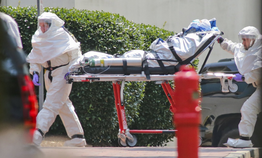By Ananya Nrusimha
The Ebola virus claimed its second victim in the United States on November 17th.
Dr. Martin Salia was a surgeon who had been treating Ebola patients in Sierra Leone. While he initially tested negative for the virus on November 7th due to a low virus load, a test on November 10th unearthed the presence of the virus in his bloodstream. On November 15th, he was flown from Sierra Leone to Omaha, where he was placed in a Biocontainment Unit. Once he arrived, doctors attempted to treat him for kidney and respiratory failure. He was placed on dialysis, ventilated, and received plasma from an Ebola survivor. Salia was also treated with ZMapp, an experimental drug for Ebola. Despite this care, Salia succumbed to the illness and died on the morning of November 17th due to cardiac arrest and heart failure.
“We used every possible treatment available,” said Phil Smith, the medical director of the Biocontainment Unit. “In Dr. Salia’s case, his disease was already extremely advanced by the time he came here for treatment.”
Dr. Salia, a native of Sierra Leone, lived in Maryland. He had just been promoted to the office of Chief Medical Officer at Kissy United Methodist Hospital, which is located in one of the poorest areas of Sierra Leone’s capital. Salia was a pious man; his decision to come to Sierra Leone was influenced by his faith, and he would often pray with his colleagues before surgeries.
“He was back in his country, helping his people,” said Salia family friend Patricia Mustapha. “He died a hero. Salia is survived by his wife and two sons.
Dr. Salia’s case highlights both the need for fast treatment and a more effective test. Had Dr. Salia been brought the United States sooner, he probably would have been able to recover from the disease like the 8 Americans who have contracted the disease so far. Instead, he met the fate of his fellow African Thomas Eric Duncan, a Liberian who was both the first identified case of Ebola on U.S. soil and the first person to die from Ebola in the United States.
The test used for Ebola can’t detect very small amounts of the virus, so patients in the early stages of the disease may receive a false negative reading. Because false negative readings are rare and because patients who receive false negative readings aren’t very contagious, they are not a public health risk.
More than 5,000 people (including at least 324 healthcare workers) have died due to the recent Ebola outbreak, which is the largest on record. The virus is most rampant in West Africa, where healthcare is generally limited and infrastructure is poor. The outbreak is occurring in both urban and rural areas, which increases the chances of healthcare workers being exposed to the virus. Early symptoms of Ebola like fever, headache and muscle pain are similar to those of diseases like malaria and meningitis, which makes diagnosis difficult. With a fatality rate of 50% and no licensed vaccine, Ebola has been running rampant through West Africa despite the best efforts of a legion of healthcare workers.

